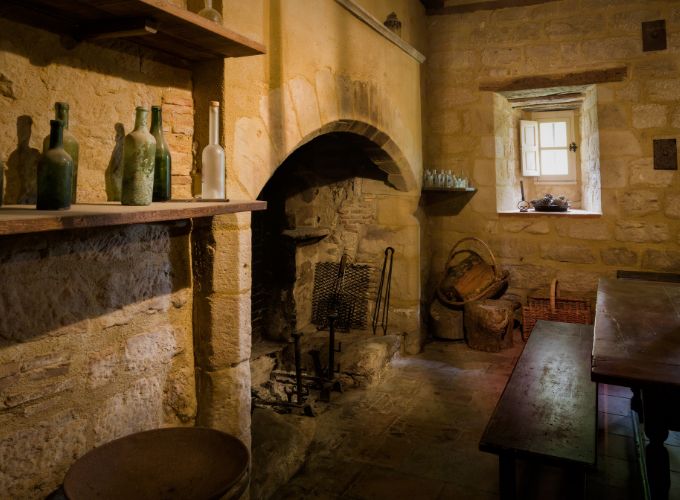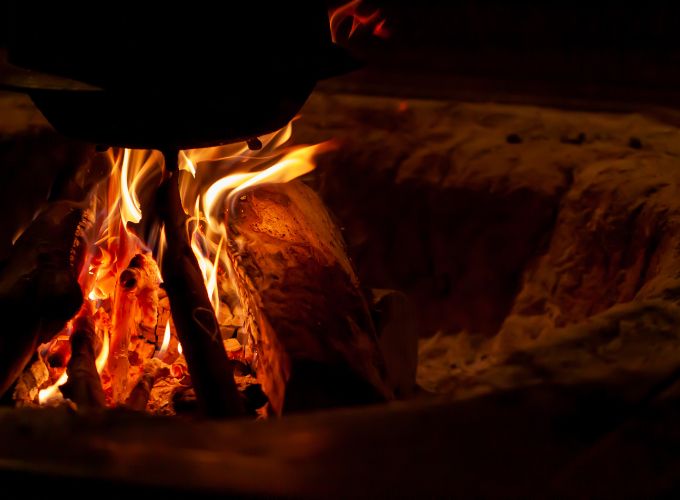
Although we enjoy the warmth of the fireplace, the odors can be unpleasant. With simple tricks like vinegar, salt, or baking soda, you can keep your home fresh and cozy.

The wood-burning fireplace has been an important symbol in different times and cultures. From medieval architecture to American history, this device has symbolised three aspects: hearth, warmth and safety.
In today’s post, we will explore the symbolism of wood-burning fireplaces by travelling back in time through these cultures.
The fireplace has been a fundamental element in architecture throughout Europe. From the Middle Ages to the present day, it has evolved and has been a staple in homes over the years. In addition to providing warmth, the fireplace has great symbolism.
In the following, we will analyse how it has evolved in medieval architecture and how it has been represented in literature and art over the centuries.
In medieval culture, the fireplace is a symbol of great importance. At that time there was no other form of heating than the warmth of a wood-burning fireplace, so they played a fundamental role in keeping houses warm.
In addition to its practical function, the fireplace in medieval architecture also symbolised wealth and social status. Large, luxurious homes had several fireplaces, while smaller ones had only one or none at all.

The hearth also symbolised a place of gathering and conviviality. Families gathered around the fire to tell stories, share news and warm themselves. The hearth became the centre of family and community life.
Architecturally, medieval fireplaces were often elaborately decorated with reliefs and carvings. They often contained religious or mythological symbolism. For example, one could see sculptures of saints or mythological figures on fireplaces, or reliefs of biblical or mythological scenes. The fireplace in medieval architecture is a symbol of importance in everyday life, both practical and symbolic, and is a fundamental part of European history and culture.
The fireplace has been a recurring symbol in these fields throughout history. As a symbol of home and warmth, the fireplace has been depicted in many works of art and literature as a place of safety, comfort and protection.
In literature, the fireplace has been used as a symbol of home and shelter in many novels and short stories. For example, in “Little House on the Prairie” by Laura Ingalls Wilder, the fireplace is the central hearth of the family. In J.R.R. Tolkien’s “The Lord of the Rings“, the hearth is the place where characters gather to tell stories and share news.
In art, the hearth has been depicted in many paintings and sculptures throughout history. For example, Jan Steen’s painting “The Fireplace” is a typical depiction of everyday life in the 17th century, where a family is seen gathered around the fireplace. We can also find the fireplace in Pierre-Auguste Renoir’s painting “The Fire in the Fireplace“, where we see a woman sitting by the fireplace, symbolising home and tranquillity.
The fireplace has been an important element in American architecture and culture since colonial times, let’s take a look at how the fireplace has evolved!
The colonial era in the United States refers to the first years after the arrival of European settlers on the American continent. It refers to the 17th and early 18th centuries. During this period, European settlers established settlements and colonies in the territory that is now the USA. These settlers brought with them their cultural and architectural traditions.
During this time, fireplaces were necessary to provide heating and cooking. However, as in medieval culture, they were a symbol of family wealth.
American Colonial architecture is known for its style of brick or stone chimneys. They were usually built in the centre of the house. They were elaborately carved and decorated with reliefs and sculptures, containing religious or mythological symbolism.
The chimney has been a recurring symbol in American history, representing independence and freedom.
During the time of the American Revolution, chimneys symbolised the independence of the colonies from Britain and the creation of a new home and country. And… how do we know this?
There are several historical references in American documents that talk about this symbolism. During the American Revolution, for example, in the famous Declaration of Independence speech of 1776, the chimney is referred to as a symbol of economic independence, “The right of the people to free choice, to a change of government, is the right of the home to have a chimney and a roof to live under“.
After independence, the chimney became a symbol of freedom and democracy in the United States. The hearth is often seen as the place where important decisions are discussed and made in a household, and this is reflected in American culture and politics. In the US Constitution, the fireplace is used as a symbol of private property rights and free speech.
The fireplace has played an important role in traditional Japanese architecture and in Australian Aboriginal culture. Let’s see what importance it has and has had over the years.
Unlike Western architecture, where the fireplace is located inside the house, in traditional Japanese architecture the fireplace is located outside the house, known as “Irori” in Japanese.
This is a stone or brick fireplace in the shape of a cube, which is located in the centre of the house. It is used for cooking, heating water and heating the house. It is also used as a place for gathering and socialising.

Traditional Japanese architecture is characterised by minimalism and simplicity, and the traditional Japanese fireplace is a reflection of this. “Irori” is a simple and elegant fireplace, which integrates perfectly into the design of the house. Furthermore, being outside the house, it is an element that blends in perfectly with the landscape and allows you to enjoy the seasons and nature.
For Australian Aboriginal people, fire is a fundamental part of their culture and religion, and the hearth is considered a sacred symbol. In Australian Aboriginal culture, fire is used for cooking, heating, lighting and religious rituals.
In addition, for Australian Aboriginal peoples, fire has a very special meaning, symbolising life and death. Fire is seen as a powerful force that has the ability to create and destroy, and is believed to have great magical power.
In conclusion, the fireplace has been an important element in different cultures and times. It has symbolised different aspects such as hearth, warmth, independence and freedom, culture and religion.
In medieval European architecture, the fireplace symbolised status and wealth. In literature and art, it was used as a symbol of hearth and warmth.
In American culture, the chimney symbolises economic independence and freedom of expression. In traditional Japanese architecture, the “Irori” fireplace is a minimalist and elegant element. In Australian Aboriginal culture, the fireplace is a sacred symbol related to religion and the magical power of fire.
Take a look at our blog and find solutions and recommendations to help you with your fireplace or wood stove.
Visit our online store for Panadero wood stoves. If you have any questions or need help choosing the right stove, don’t hesitate to contact us. We will be happy to help you.
Articles of interest:
Did you like this article? If so, help us spread it 😊 . Click on the buttons below here and feel free to share it on your social networks!
Thank you for reading!
↓ ↓ ↓ ↓

Although we enjoy the warmth of the fireplace, the odors can be unpleasant. With simple tricks like vinegar, salt, or baking soda, you can keep your home fresh and cozy.

How to avoid dust in the house when using a wood stove: tips and tricks for a clean and healthy home

Learn how to remove mould from your wood for use by following the steps in this article.

All you need to know: what it is, uses and benefits of wood stoves
To provide the best experiences, we use technologies like cookies to store and/or access device information. Consenting to these technologies will allow us to process data such as browsing behavior or unique IDs on this site. Not consenting or withdrawing consent, may adversely affect certain features and functions.